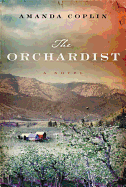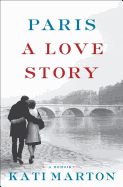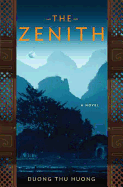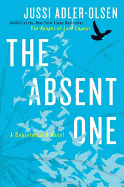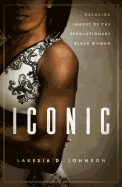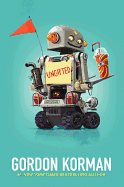Friday, August 24, 2012
Earlier this year, I received a lovely paperback called What Is Reading For?--$19.95, only 40 pages, but what lovely pages. Written and designed by Robert Bringhurst, it's a 450-copy limited edition printed on Mohawk Ticonderoga paper, with French flaps. The cover has archaic Greek text (in Dan Carr's Parmenides) and Han Chinese phrases front and back (Adobe Kaiti, Microsoft Mincho and Ryoko Nishizuka's Kazuraki); the text face is Trinité, the titling face is Rialto. Font geeks will get it; the rest can "merely" admire a piece of bookmaking art. The text is an essay about the future of reading; Bringhurst writes about scribal cultures and the visceral bond between script and reader, the erosion of the bond when printing comes to the culture and the future of reading with the advent of digital books. He says it's natural to feel anxiety as books "molt from one form or instar to another" because we know, "in our guts or our bones, that books are important. But so long as we do know they're important, they may survive. Whatever they're molting into now, this metamorphosis is quite unlikely to be the last."
A few months ago, I received a baseball memoir--always an occasion--called Johnny Antonelli, by himself with Scott Pitoniak. Antonelli was a phenom who signed with the Boston Braves in 1948, a few days after graduating from high school. After being traded to the New York Giants, he became one of the sport's best pitchers, with a 114-89 record, 22 shutouts and nine saves. This is a handsomely produced book--smooth cover, pleasant (albeit unidentified) typeface and photographs.
What these two books have in common is their publisher: RIT Press, a co-imprint of RIT Cary Graphic Arts Press, from Rochester Institute of Technology. They make some fine books. Originally focused on graphic arts (gorgeous calligraphy books), the press has expanded into other subjects,--deaf studies, business, science, poetry, even cards and posters. Check out their website at your own monetary risk. --Marilyn Dahl, reviews editor, Shelf Awareness
The Orchardist
by Amanda Coplin
It's said that no good deed goes unpunished, and Amanda Coplin exploits the dramatic possibilities of this maxim in her debut novel, The Orchardist. Her do-gooder is William Talmadge, the titular orchardist, who has lived alone on a vast homestead in Wenatchee Valley in Washington State ever since his teenage sister disappeared during a herb-foraging walk in 1865. Talmadge has preserved the wild forested area where her bonnet was found as a sort of tribute and devoted himself to the meticulous husbandry of 25 acres of apricot, plum and apple trees. His social interactions are modest: the transitory company of horse wranglers who barter orchard work for camping rights and a chaste friendship with the midwife who lives on the edge of town.
Talmadge's inciting good deed is to refuse to let a righteous townie pursue two nearly feral girls who dash off with skirtsful of apples on market day. A few days later, the runaways, who are sisters--both pregnant--track their benefactor back to his orchard, where Talmadge, impelled to continue helping them, sows the seeds for his ensuing punishment. (A tender reward is grafted onto the bargain.)
With its frontier setting, fierce female characters and abiding themes of loss and revenge, The Orchardist recalls Charles Portis's True Grit and John Steinbeck's East of Eden. Coplin, the granddaughter of an orchardist, offers gorgeous evocations of the Wenatchee Valley's seasons and rituals. This is an extraordinarily ambitious and authoritative debut. --Holloway McCandless, blogger at Litagogo: A Guide to Free Literary Podcasts
Discover: An absorbing and gratifying debut novel about a turn-of-the-century Wenatchee Valley orchardist whose kindness toward a pair of runaway sisters transforms his final decades.
Lionel Asbo: State of England
by Martin Amis
Who hasn't seen photos of a stunned lottery winner posing with an oversized check and wondered how those riches will change their lives? Now imagine that the bemused winner is a congenital criminal in a grimy industrial suburb of London and you can begin to grasp the comic possibilities of Martin Amis's 13th novel, Lionel Asbo: State of England.
Lionel--who changed his name to "Asbo" in honor of his frequent encounters with England's Anti-Social Behaviour Orders--works in the "very hairiest end of debt collection," making his rounds with a pair of pit bulls that will figure prominently in the novel's terrifying climax. After Desmond's mother dies, Lionel becomes his nephew's unofficial guardian. While Lionel is serving one of his frequent brief prison terms, Des fills out a lottery ticket for his uncle that wins £139 million.
It doesn't take long for the "Lotto Lout," as the British tabloids dub Lionel, to ensconce himself in a gothic mansion with a girlfriend whose obsessions are cosmetic surgery and bad poetry. Deploying his accomplished satirical gifts with surgical skill, Amis delivers a grimly humorous portrayal of life among lower-class Britons alongside an equally incisive glimpse of the perils of undeserved celebrity.
If Lionel Asbo merely were the story of one dubious character's mishaps after coming into unearned riches, it would be amusing enough. But Amis is also concerned with the complex relationship between Lionel and Desmond, and through them the sometimes inexplicable bonds that tie family members to each other and the ways we can love against all our better instincts. --Harvey Freedenberg, attorney and freelance reviewer
Discover: Martin Amis's 13th novel is a satiric look at what happens when a career criminal becomes a lottery multimillionaire.
The Zenith
by Duong Thu Huong, transl. by Stephen B. Young and Hoa Pham Young
Duong Thu Huong's The Zenith has a Matryoshka doll construction that shows the linkage between trust and betrayal, blindness and visibility. In the novel's central narrative, the Vietnamese ruler Ho Chi Minh is a Lear-like figure whose delusion of sainthood turns him into a figurehead and destroys those closest to him. This contrasts to the stories of a charismatic woodcutter whose instinctual awareness of traditional mores allows him to break taboos, and the unraveling of a marriage long considered a perfect union between two individuals within Ho's personal circle.
Huong's meticulous fictional portrait of Ho Chi Minh shows how his blind trust in the infallibility of shared power strips him of all authority, exiling him to the "zenith" of an isolate mountain in North Vietnam. His impotence parallels the plight of Tran Vu, who does not see until too late that his beautiful wife--like his revolutionary ideal--is morally bankrupt. On the other hand, the woodcutter's steadfastness embodies Huong's core message: Communism's death knell lies in its rejection of both traditional values and individual rights, such as religion, filial piety, sexual freedom and personal honesty. Throughout The Zenith, Huong shows that no political system can remain viable if it is divorced from these main elements of the human experience. --Thuy Dinh, editor, Da Mau magazine
Discover: A vivid reimagining of Ho Chi Minh shows the leader in human dimensions.
Tubers
by Mark Jowett with art by Matthias Lechner
The nine stories in Mark Jowett's Tubers are thematically linked by subways, not just as a means of getting from one place to another but as a zone in which to find intriguing characters. Taking the Paris Métro, the London Underground and New York's MTA system as his muses, Jowett probes the turbulent lives of an assortment of characters. Each city gets three stories, one of which draws upon Jowett's background in the indie music industry, all of them supplemented by two-page illustrations by Matthias Lechner.
These stories often have a violent bent to them, like the one about the confrontation between a man dressed up as Van Gogh's self-portrait and a deranged goalie on their way to the Greenwich Village Halloween parade, but sometimes the weirdness goes in a different direction, as when a teenage photographer becomes a serial voyeur for a couple who like to have sex on the Métro. Lechner's pictures work with tight color spectrums; one spread might be dominated by reds and blues, the next by oranges and yellows. Tubers comes with a 45 RPM single; the "Tweety Bird" song actually plays a role in the eponymous story, though its cute, poppish tone is at odds with the story's fraught tensions. (You can download MP3s for all of the stories; most tend toward mood-setting electronica, while a few offer direct commentary.) Though the quality is uneven and O. Henry himself would blush to dare some of these trick endings, when Jowett gets deep enough into his characters' heads, the results can be arresting. --Ron Hogan, founder of Beatrice.com
Discover: Ever been on a subway or bus and wondered about the lives of the people sitting across from you? Mark Jowett has nine different takes on that imaginative impulse.
The Lost Prince
by Selden Edwards
Fans of Selden Edwards's debut novel, The Little Book, will quickly recognize some key names in The Lost Prince. At the center of the novel is Eleanor Putnam, who returns home to Boston from Vienna in 1898 with a mysterious journal that is both a gift and a curse. The time-bending story includes friendships between Eleanor and J.P. Morgan, Carl Jung and Gustav Mahler--and a struggle with destiny versus free will that craftily sets fateful acts in motion while sweeping readers into a passionate love affair.
Selden opens the novel in 1918 Boston, then quickly jumps back 20 years to Vienna; the movement among times and settings requires patience, but all shall be revealed, and "aha!" moments are worth the wait. Ever-gracious Eleanor is smart and privileged, but also bears a secret burden of knowing (or determining?) the future. She foresees the world wars; she's certain the Titanic will sink. While Eleanor marries Frank Burden and fulfills her destiny, she mourns the "love of her life" and obsesses about attracting a young Austrian teacher named Arnauld Esterhazy to a prestigious Boston boys' school. Selden enhances the intriguing character development with much historical detail, touching upon the politics and battles of the First World War, the fate of the Habsburgs, the differences between Freud and Jung's theories and the social mores of the era.
Though The Lost Prince stands alone, as a sequel to The Little Book it's even richer. --Cheryl Krocker McKeon, bookseller
Discover: A gorgeously imagined and richly historic novel set in Boston and Vienna from the 1890s through the First World War.
Mystery & Thriller
A Killing in the Hills
by Julia Keller
Pulitzer Prize-winning journalist Julia Keller makes her mystery debut with A Killing in the Hills, a love song to her native West Virginia that's as beautiful as it is gritty.
Belfa "Bell" Elkins, prosecuting attorney of Raythune County, already had her work cut out for her as she debated whether to prosecute a mentally handicapped man called Albie Sheets to the fullest extent of the law for the killing of a small boy or lighten the charges in the belief he did not understand his own actions. Now her teenage daughter, Carla, has witnessed the drive-by slaying of three elderly men and is acting more surly and secretive than ever. Believing the triple homicide yet one more symptom of the drug problem that's tearing apart her hometown of Acker's Gap, Bell aggressively pursues the case despite an attempt on her life.
The killer, a disturbed young man who calls himself "Chill" and answers to a shadowy boss, eludes the authorities, but Carla is certain she knows his face if not his name, and she pursues Chill's identity without her mother's knowledge.
Bell Elkins is an appealing heroine, fiercely protective of her family and home and stubborn in her pursuit of justice. The ensemble cast brings a sense of community to the story and gives readers insight into Bell's steadfast determination to preserve the culture of Acker's Gap. With ample loose ends left to begin a second book, readers may justifiably hope to see more of Keller's sure-footed prose and dynamic characters. --Jaclyn Fulwood
Discover: Julia Keller makes her mystery debut with a novel set in her native West Virginia that's as beautiful as it is gritty.
The Absent One
by Jussi Adler-Olsen
Jussi Adler-Olsen's The Absent One, the second installment in the Department Q series, has a suspenseful opening that portends a very bad outcome. Then the story cuts to Carl Mørck, the Danish detective whose laziness belies a sharp mind, as he receives the file on a 20-year-old double homicide that by all appearances is solved, with the confessed murderer in prison. But it soon becomes apparent that the murders involved several other players still at large, including an elusive and dangerous homeless woman named Kimmie. Mørck and his trusty assistant Assad decide to reopen the investigation and come face to face with people who would kill again to keep their secrets safe.
Adler-Olsen structures the story so readers know who the bad guys are early on; the draw is in rooting for Mørck and Assad to figure things out and make the smug sociopaths pay for their crimes (perhaps in violent, painful ways). One member of the gang is surprisingly sympathetic, however, revealing Adler-Olsen's ability to show the humanity in even the vilest of people.
He's also adept at injecting humor into a grim tale, like Mørck's observation that another character's "boozy breath" is "day-old, but of quality origin." Assad continues to be a delightful sidekick who keeps revealing hints of a more sinister side. Each Department Q book is self-contained, but Adler-Olsen knows how to tease with serial details that will keep readers showing up for more. --Elyse Dinh-McCrillis, freelance writer/editor, blogging at Pop Culture Nerd
Discover: Carl Mørck and his assistant Assad solve a 20-year-old double homicide in the second installment of this Danish mystery series.
Biography & Memoir
Paris: A Love Story
by Kati Marton
In Paris: A Love Story, NPR and ABC News correspondent Kati Marton lays bare her extraordinary love for the City of Lights as well as her grief over the loss of Richard Holbrooke, her third husband. Beginning with Holbrooke's death in 2010, Marton brings the reader along on a journey through her childhood, her marriage to (and divorce from) fellow ABC News correspondent Peter Jennings and her years with Holbrooke, all centered on Paris--the city in which "Kati is more Kati" than in any other place, as Holbrooke put it.
The daughter of Hungarian immigrants to the U.S., Kati Marton first fell in love with Paris during a study abroad year at the Sorbonne. Ten years later, she learned to adore the city through fresh eyes during her tumultuous and passionate relationship with Jennings. As that marriage crumbled, Marton returned to France, where a whirlwind trip through the Loire Valley with Holbrooke led to 17 years of marriage--and an apartment just blocks from Marton's student lodgings so many years before. As she recounts this story, Marton shares her deep love for her family as well as her grief, which plays out in cycles, striking both the author and the reader at odd moments with extraordinary force. Paris: A Love Story is a memoir that is as much about loving Paris as it is about loving another person. --Dani Alexis Ryskamp, blogger at The Book Cricket
Discover: An emotionally candid exploration of love and grief against the backdrop of an equally beloved city.
Current Events & Issues
The Myth of the Muslim Tide
by Doug Saunders
Douglas Saunders has spent much of his career reporting on Islamic extremism around the world, and by his own admission he is no apologist for Islam. Yet, in The Myth of the Muslim Tide, he challenges the increasingly popular argument that Western society is on the verge of being overrun and undermined by Islamic immigrants.
Though some will find his arguments controversial, Saunders maintains a moderate tone. Following a brief history of what he terms "crescent fever," Saunders methodically debunks the major claims of the anti-Muslim movement, which he divides into three types: those related to population growth, those dealing with immigrants' integration into their host cultures and those linking immigrants to Muslim extremism.
Saunders's most powerful argument comes not from his skillful use of demographic and other statistical data, but from his appeal to history. In a brief section titled "We've Been Here Before," Saunders compares the claims of modern Islamophobia with the fears surrounding Jewish and Catholic immigrants through the first half of the 20th century. The similarity of the claims is startling, and, of course, time has proven them to be untrue.
Saunders ends with a discussion of what he terms "the real issues," undeniable problems in Muslim immigrant communities and concrete proposals for their solution. The Myth of the Muslim Tide is an important book on a topic with serious implications for Western electoral politics. --Pamela Toler, blogging at History in the Margins
Discover: An intelligent and clear refutation of Western fears about Muslim immigration.
Iconic: Decoding Images of the Revolutionary Black Woman
by Lakesia D. Johnson
Iconic opens with a 2008 interview between Larry King and Michelle Obama in which he repeatedly asked whether false accusations about her husband angered her. Lakesia D. Johnson then explains how Mrs. Obama defused the line of questioning, successfully separating herself from the historically entrenched stereotype of the angry black woman. "A shadow is cast when light is placed on an object--the light of public scrutiny that black women face when they dare to speak truth to power," Johnson writes. "Selling the 'shadow' is one of the strategies that African American women have learned to use to make sure that 'the substance' of who they are, the struggles that they face, and the good they desire are not obscured by the insidious narratives and images of black people that support racism, sexism, and other forms of oppression."
Iconic is a fascinating survey of how revolutionary black women have managed to "sell the shadow" throughout history, from Angela Davis and Kathleen Cleaver to Pam Grier and Alice Walker, from Audre Lorde to Erykah Badu and Me'shell Ndegeocello--returning to Michelle Obama in the concluding chapter. While Johnson, a professor of gender and women's studies at Grinnell College, explores why black women have been portrayed as dangerous, subversive and angry, she primarily focuses on those "engaged in progressive or revolutionary politics designed to achieve social justice," the women best able to "resist oppression and redefine black womanhood." And, true to its name, Iconic features many illuminating images that visually emphasize Johnson's premise. --Kristen Galles from Book Club Classics
Discover: A fascinating survey of how African American women have subverted stereotypes and created authentic identities throughout the years.
Children's & Young Adult
Long Lankin
by Lindsey Barraclough
Lindsey Barraclough chillingly reimagines Long Lankin, the nightmarish man of English lore, in this highly impressive debut set in a small village in post–World War II England.
The story begins as Cora and Mimi are sent to live with their great-aunt Ida in Guerdon Hall. Cora attributes Ida's strange and specific rules to that of an old woman who doesn't want children living with her. Why else would she forbid them to open windows, even in summer? It soon becomes clear that Ida's rules stem from her fears of something sinister. With the help of a local boy, Roger, Cora begins to uncover the tragedies of the village's past. Long Lankin has terrorized Bryers Guerdon and the Guerdon family for centuries. Now he's returned and has set his sights on Mimi.
Long Lankin is an intense journey that is carefully paced and wonderfully dark. Throughout the book, readers remain terrified of a character constantly just off-screen, who could be lurking in every shadow, yet makes relatively few appearances--which is reinforced by the townspeople's reluctance to discuss him. Barraclough shifts the narrative among the characters' viewpoints and balances aspects of legend and mystery perfectly, raising more questions for readers with every answer, more concerns with every rescue. Shrouded in darkness, the character of Long Lankin will haunt readers long after the book's final pages. --Kyla Paterno, trade book buyer and blogger, Garfield Book Company at PLU
Discover: The terrifying legend of Long Lankin with a post–World War II twist.
The Insomniacs
by Karina Wolf, illus. by Brothers Hilts
A family resembling a Charles Addams creation learns how to live during the night in this visual feast.
Karina Wolf, in her first picture book, charts a family that shifts from being a normal one that drives, goes to school and takes photographs during the sunlight hours, to one that "stayed awake only in nighttime." They've moved 12 time zones away for Mrs. Insomniac's new job. Mother nods off at her desk, Father falls asleep taking pictures, and the headmistress sends Mika home from school with a diagnosis of "sleeping sickness." The Brothers Hilts depict dark, shadowy rooms with people and mice in profile, and green, gold and red bottles gleaming in the few rays of sun. Mika's purported sickness is a wakeup call to the whole family. But nothing works, until they quiz their nocturnal neighbors.
The book's design juxtaposes velvety interiors of the Insomniacs' house with vignettes of them plotting to learn the bear's secret to how he beds down all winter long. A gorgeous image of the family members in search of the bears on a rolling landscape lit only by their lamps and a hint of sun on the horizon complements a curving colony of bats. A porthole view of owls, fireflies in a dense thicket of grass and a herd of moose approaching a pond all attest to a thriving nighttime scene.
In the end, the message is clear: If you accept your circumstances, you're more likely to figure out the best next steps. --Jennifer M. Brown, children's editor, Shelf Awareness
Discover: A fresh twist on a favorite warhorse about postponing sleep thanks to glorious artwork by the Brothers Hilts.
Ungifted
by Gordon Korman
Gordon Korman (Schooled) offers another winner, starring surprisingly appealing antihero Donovan Curtis, a reckless eighth-grader with extremely poor impulse control.
Donovan can't resist "throwing darts at a pool float to test my sister's swimming skills, or spitting back at the llamas at the zoo." It gets worse. One day, Donovan uses a baseball bat to break the statue of Atlas on his middle school campus. He sends the globe flying into the gym doors, shattering them completely. But instead of Donovan getting expelled or arrested, a paperwork glitch sends him to the district's school for the gifted. There, hiding out from the superintendent, Donovan finds a way to fit in. He may not be gifted like the other students, but he brings them social skills and a sense of normalcy. He unites the robotics group, for instance, and gives their prized robot a name (Tin Man), then uses his video game experience to win the job of driving it. And he convinces his very pregnant sister to fill in for the Human Growth and Development class that the group missed, allowing them to graduate without summer school. But since the gym at his old school is still out of commission, the superintendent decides to move the spring dance to the gifted academy--and Donovan's worlds collide.
Korman demonstrates how many gifts one "ungifted" kid can bring to a classroom full of geniuses. This wacky yet well-crafted novel explores the fish-out-of-water theme with freshness and pizzazz. --Lynn Becker, host of Book Talk, the monthly online discussion of children's books for SCBWI
Discover: A spot-on comedy about a middle school troublemaker who transforms, and is transformed by, a school for the gifted.


